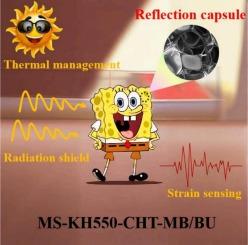Multifunctional melamine-sponge composites with reflection capsules for radiation shielding in nuclear environments
IF 4.3
2区 工程技术
Q2 ENGINEERING, CHEMICAL
引用次数: 0
Abstract
This study focused on radiation shielding materials for nuclear applications, employing a vacuum-assisted impregnation method to optimise the microstructure and establish a synergistic shielding mechanism combining scattering and absorption. Specifically, melamine sponge (MS) is first modified using KH550 to form –NH2 active sites on its pore surfaces. Subsequently, it is immersed in a composite solution to construct “reflective capsules”. Finally, gradient encapsulation is performed using polyborosiloxane and polyurethane. The results show that compared with pure MS, the tensile strength of this material doubles, the elongation increases by 179 %, and its shielding capabilities against 59.6 keV γ-rays and 0.025 keV thermal neutrons increase by 1442 % and 1593 % respectively, reaching 27.14 % and 43.35 %. Additionally, it has a photothermal peak temperature of 78.5 °C and stable thermal response. Furthermore, relying on the three-dimensional elastic network of the MS and the conductive pathway of MXene, the material achieves a piezoresistive coefficient of 5.27 kPa−1, demonstrating potential for application as a pressure-sensitive sensor. Through microstructure design and functional integration, this work makes the material suitable for complex scenarios such as nuclear facility maintenance and emergency rescue.


核环境辐射屏蔽用反射胶囊多功能三聚氰胺-海绵复合材料
本研究以核用辐射屏蔽材料为研究对象,采用真空辅助浸渍的方法,优化其微观结构,建立散射与吸收相结合的协同屏蔽机制。具体而言,首先使用KH550对三聚氰胺海绵(MS)进行改性,使其孔表面形成-NH2活性位点。随后,将其浸入复合溶液中构建“反射胶囊”。最后,采用聚硼硅氧烷和聚氨酯进行梯度封装。结果表明,与纯MS相比,该材料的抗拉强度提高了一倍,伸长率提高了179%,对59.6 keV γ射线和0.025 keV热中子的屏蔽能力分别提高了1442%和1593%,分别达到27.14%和43.35%。光热峰值温度为78.5℃,热响应稳定。此外,依靠MS的三维弹性网络和MXene的导电途径,该材料的压阻系数达到5.27 kPa−1,显示出作为压敏传感器的应用潜力。本工作通过微结构设计和功能集成,使材料适用于核设施维修和应急救援等复杂场景。
本文章由计算机程序翻译,如有差异,请以英文原文为准。
求助全文
约1分钟内获得全文
求助全文
来源期刊

Chemical Engineering Science
工程技术-工程:化工
CiteScore
7.50
自引率
8.50%
发文量
1025
审稿时长
50 days
期刊介绍:
Chemical engineering enables the transformation of natural resources and energy into useful products for society. It draws on and applies natural sciences, mathematics and economics, and has developed fundamental engineering science that underpins the discipline.
Chemical Engineering Science (CES) has been publishing papers on the fundamentals of chemical engineering since 1951. CES is the platform where the most significant advances in the discipline have ever since been published. Chemical Engineering Science has accompanied and sustained chemical engineering through its development into the vibrant and broad scientific discipline it is today.
 求助内容:
求助内容: 应助结果提醒方式:
应助结果提醒方式:


